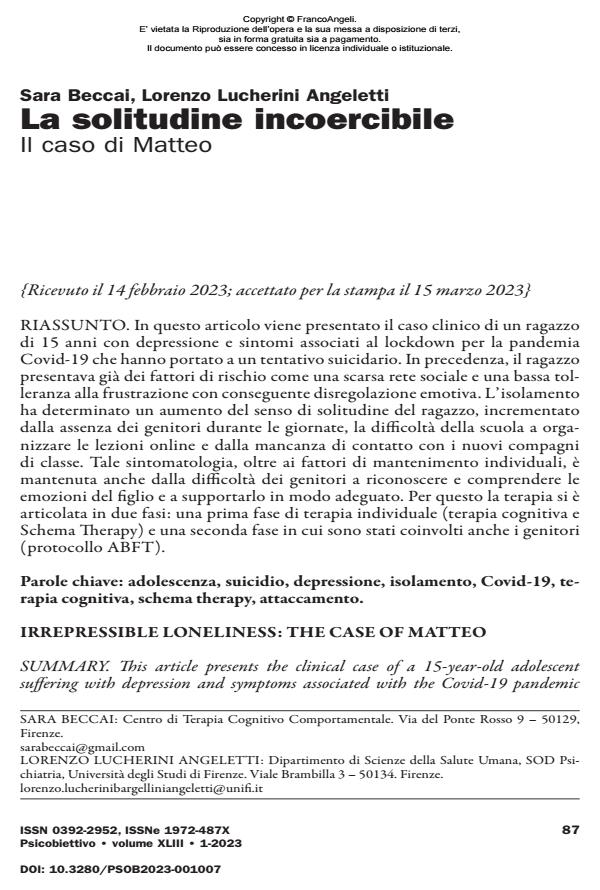Irrepressible loneliness: the case of Matteo
Journal title PSICOBIETTIVO
Author/s Sara Beccai, Lorenzo Lucherini Angeletti
Publishing Year 2023 Issue 2023/1 Language Italian
Pages 10 P. 87-96 File size 629 KB
DOI 10.3280/PSOB2023-001007
DOI is like a bar code for intellectual property: to have more infomation
click here
Below, you can see the article first page
If you want to buy this article in PDF format, you can do it, following the instructions to buy download credits

FrancoAngeli is member of Publishers International Linking Association, Inc (PILA), a not-for-profit association which run the CrossRef service enabling links to and from online scholarly content.
This article presents the clinical case of a 15-year-old adolescent suffering with depression and symptoms associated with the Covid-19 pandemic lockdown, that led to an attempted suicide. The adolescent previously displayed risk factors such as a poor social network and low frustration tolerance, resulting in emotional dysregulation. Isolation resulted in an increased sense of loneliness for the adolescent, augmented by the absence of parents during the daytime, the school’s difficulty in organizing online classes, as well as the lack of contact with new classmates. This symptomatology, in addition to individual maintenance factors, was also maintained by the parents’ difficulty in recognizing and understanding their son’s emotions and supporting him appropriately. Therefore, therapy was divided into two phases: a first phase of individual therapy (cognitive therapy and Schema Therapy) and a second phase, in which parents were also involved (ABFT protocol).
Keywords: adolescence, suicide, depression, isolation, Covid-19, cognitive therapy, schema therapy, attachment.
- APA – American Psychiatric Association (2014). DSM-5. Manuale diagnostico e statistico dei disturbi mentali, a cura di M. Biondi. Milano: Cortina.
- Beck A.T. et al. (1987). Terapia Cognitiva della depressione. Torino: Bollati Boringhieri.
- Bowlby J. (1988). A secure base: parent-child attachment and healty humandeve- lopment. New York: Basic Books.
- Cacioppo J.T., Cacioppo S., Capitanio J.P., Cole S.W. (2015). The neuroendo- crinology of social isolation. Annual Review of Psychology. 66: 733-767.
- Calati R., Ferrari C., Brittner M., Oasi O., Olié E., Carvalho A.F. et al. (2019).
- Suicidal thoughts and behaviors and social isolation: a narrative review of the literature. Journal of Affective Disorders. 245: 653-667.
- Cooper K., Hards E., Moltrecht B., Reynolds S., Shum A., McElroy E., Loades
- M. (2021). Loneliness, social relationships, and mental health in adolescents during the Covid-19 pandemic. Journal of Affective Disorders, 289: 98-104.
- Diamond G.S., Reis B.F., Diamond G.M., Siqueland L., Isaacs L. (2002). Attachment-based family therapy for depressed adolescents: A treatment de- velopment study. Journal of the American Academy of Child and Adolescent Psychiatry, 41(10): 1190-1196. DOI: 10.1097/00004583-200210000-00008
- Diamond G.S., Siqueland L., Diamond G.M. (2003). Attachment-based family family therapy: Programmatic treatment development. Clinical Child and Family Psycholgy Rview, 6: 107-127. DOI: 10.1023/A:1023782510786
- Diamond G.S., Winterseen M.B., Brown G.K., Diamond G.M, Gallop R., Shelef K., Levy S. (2010). Attachment-based family therapy for adolescents with suicidal ideation: a randomized controlled trial. Journal of the American Academy of Child and Adolescent Psychiatry, 49(2): 122-131. DOI: 10.1097/00004583-201002000-00006
- Diamond G.S., Creed T., Gillham J., Gallop R., Hamilton J.L. (2012). Sexual trauma history does not moderate treatment outcome in attachment-based fa- mily therapy (ABFT) for adolescents with suicide ideation. Journal of Family Psychology, 26: 595-605.
- Diamond G.S., Diamond G.M, Levy S.A. (2014). Attachment-based family the- rapy. American Psychological Association (APA).
- Ducasse D., Olié E., Guillaume S., Artéro S., Courtet P. (2015). A meta analysis of cytokines in suicidal behavior. Brain, Behavior, and Immunity, 46: 203-211.
- Gotlib I.H., Miller J.G., Borchers L.R., Coury S.M., Costello L.A., Garcia J.M., Ho T.C. (2022). Effects of the Covid-19 Pandemic on Mental Health and Brain Maturation in Adolescents: Implications for Analyzing Longitudinal Data. Biological Psychiatry Global Open Science.
- Gulliver A., Griffiths K., Christensen H. (2010). Perceived barriers and facilita- tors to mental health help-seeking in young people: a systematic review. BMC Psychiatry, 10: 113. DOI: 10.1186/1471-244X-10-113
- Lambruschi F. (2014). Psicoterapia Cognitiva dell’età evolutiva. Procedure di asses- sment e strategie psicoterapeutiche. Torino: Bollati Boringhieri.
- Loades M.E., Chatburn E., Higson-Sweeney N., Reynolds S., Shafran R., Brigden A., Linney C., McManus M.N., Borwick C., Crawley E. (2020). Rapid Systematic Review: The Impact of Social Isolation and Loneliness on the Mental Health of Children and Adolescents in the Context of Covid-19. Journal of the American Academy of Child and Adolescent Psychiatry, 59(11): 1218-1239. e3.
- Loose C. (2012). New approach for Schema Therapy with Children. Workshop. New York; ISTT-Conference.
- Loose C., Graaf P., Zarbock G. (2013). Schematherapie mit kindern und Jungendlichen (trad. it.: La schema therapy con bambini e adolescenti. Milano: Istituto di Scienze Cognitive Editore, 2017).
- Lorenzini R., Sassaroli S. (2000). La mente prigioniera. Strategie di terapia cognitiva. Milano: Cortina.
- Melhem N.M., Keilp J.G., Porta G., Oquendo M.A., Burke A., Stanley B. et al. (2016). Blunted HPA axis activity in suicide attempters compared to those at high risk for suicidal behavior. Neuropsychopharmacology, 41: 1447-1456.
- Mental Health Foundation (2020). Loneliness during Coronavirus. -- Available at: www.mentalhealth.org.uk/coronavirus/loneliness-during-coronavirus.
- Olié E., Jollant F., Deverdun J., de Champfleur N.M., Cyprien F., Le Bars E. et al. (2017). The experience of social exclusion in women with a history of suicidal acts: a neuroimaging study. Scientific Report, 7(1): 89.
- Slavich G.M., O’Donovan A., Epel E.S., Kemeny M.E. (2010). Black sheep get the blues: a psychobiological model of social rejection and depression. Neuroscience & Biobehavioral Reviews, 35(1): 39-45.
- Velasco A., Cruz I.S.S., Billings J. et al. (2020). What are the barriers, facilitators and interventions targeting help-seeking behaviours for common mental health problems in adolescents? A systematic review. BMC Psychiatry, 20: 293.
- WHO (2018). Adolescents: health risks and solutions. Geneva: World Health Organization. -- www.who.int/en/news-room/fact-sheets/detail/adolescents-health- risks-and-solutions.
Sara Beccai, Lorenzo Lucherini Angeletti, La solitudine incoercibile. Il caso di Matteo in "PSICOBIETTIVO" 1/2023, pp 87-96, DOI: 10.3280/PSOB2023-001007